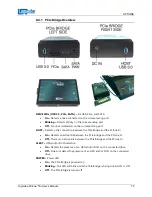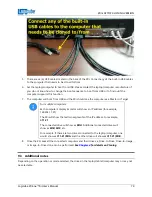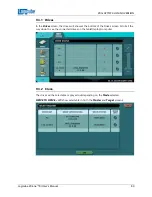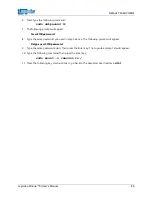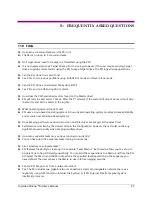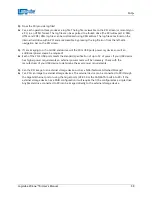
Logicube ZClone™Xi User’s Manual
87
11: FREQUENTLY ASKED QUESTIONS
11.0 FAQs
Q.
How many concurrent tasks can the ZXi run?
A.
The ZXi can run up to 5 concurrent tasks.
Q.
Do Target drives need to be wiped or formatted using the ZXi?
A.
It is not necessary to wipe Target drives prior to cloning. However, if the user requires wiping Target
drives, Logicube recommends using the ZXi to wipe Target drives. The ZXi logs all wipe operations.
Q.
Can the ZXi clone Linux partitions?
A.
Yes. ZXi can clone Linux partitions using both Mirror mode and Clever Clone mode.
Q.
Can the ZXi clone a Hierarchical File System (HFS)?
A.
Yes, ZXi can clone HFS using Mirror mode.
Q.
How does the ZXi handle bad sectors found on the Master drive?
A.
ZXi will retry the bad sector 7 times. After the 7
th
attempt, if the sector still cannot be read, it will skip
that sector and list the sector in the log file.
Q.
What operating system does ZXi use?
A.
ZXi uses a Linux-based operating system. A Linux-based operating system provides increased stability
and security over Windows-based systems.
Q.
Does imaging performance slow down when multiple drives are imaged at the same time?
A.
Performance is limited by the slowest drive in the configuration, however, there should not be any
significant speed penalty when imaging multiple drives.
Q.
How many separate tasks can you have running concurrently?
A.
You can have up to five separate tasks running concurrently.
Q.
Can I schedule or automate tasks?
A.
ZXi features the ability to create up to 5 separate “Tasks Macros”. Each macro allows you to set up to
9 operations to be performed sequentially. You can add these operations to a Macro and from the ZXi
GUI select the Macro and the ZXi will perform the specified tasks/operations in the sequence you
have defined. The user can save the Macro to use in future imaging sessions.
Q.
Can the ZXi image to or from a network location?
A.
Yes. The ZXi includes two gigabit network connections. Users can designate a network share as a
repository using CIFS (Common Internet File System) or iSCSI (Internet Small Computer System
Interface) protocols.



